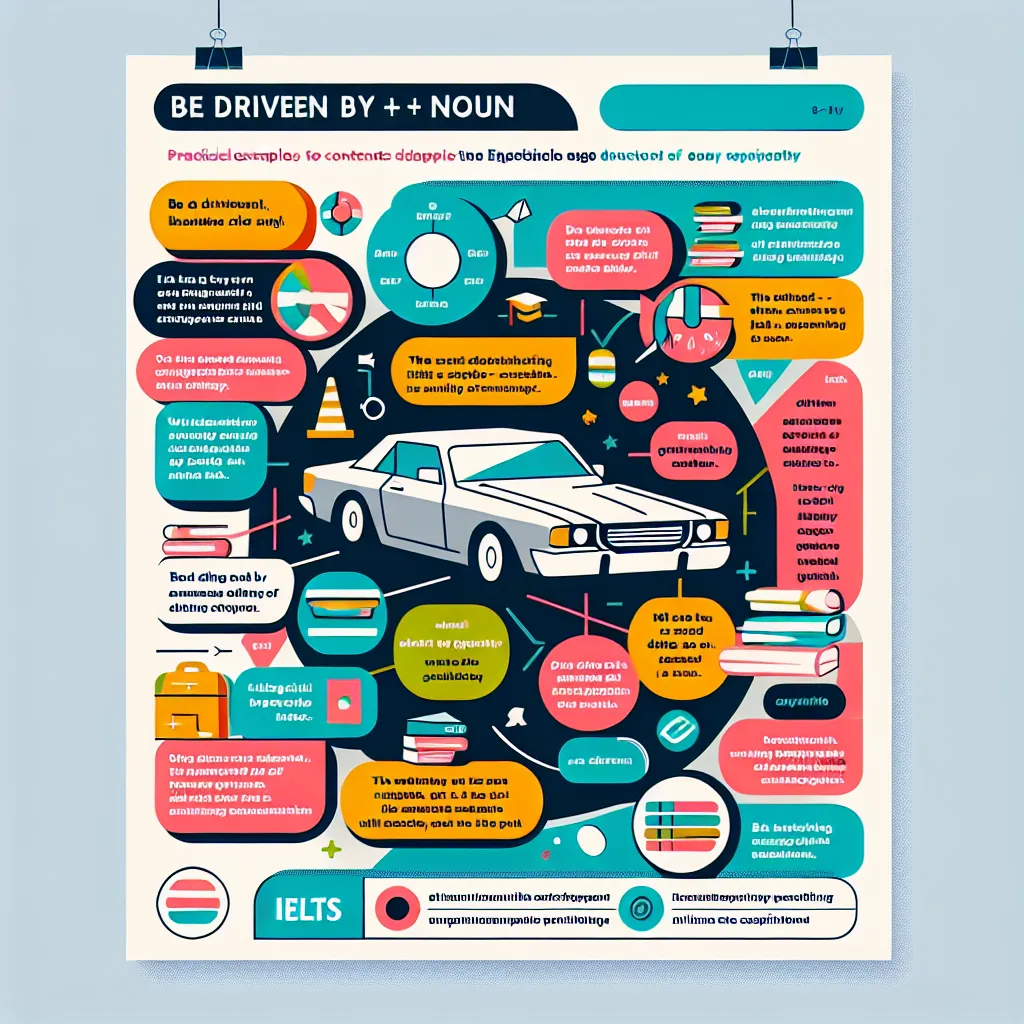The “be driven by + noun” structure is a powerful and versatile grammatical construction that frequently appears in IELTS exams. Understanding and utilizing this structure effectively can significantly enhance your language proficiency and help you achieve a higher band score. Let’s delve into the intricacies of this structure and explore how to apply it in various IELTS contexts.
Understanding the “Be Driven by + Noun” Structure
The “be driven by + noun” structure is used to express the main force or motivation behind an action, decision, or phenomenon. It emphasizes the causal relationship between the driving force (noun) and the subject being affected. This structure is particularly useful in academic and professional contexts, making it highly relevant for IELTS candidates.
Examples:
- The company’s success is driven by innovation.
- Climate change is driven by human activities.
- Economic growth is often driven by technological advancements.
- Her career choices were driven by passion for social justice.
- The project’s timeline was driven by strict deadlines.
In each of these examples, the bolded part represents the core structure, followed by a noun or noun phrase that indicates the driving force.

Grammar Formula and Usage in IELTS
The basic formula for this structure is:
[Subject] + [be verb] + driven by + [noun/noun phrase]
It’s important to note that the “be verb” should agree with the subject in tense and number. For instance:
- Singular present: is driven by
- Plural present: are driven by
- Singular past: was driven by
- Plural past: were driven by
Application in IELTS Writing
In IELTS Writing Task 2, this structure can be particularly effective in developing arguments and explaining causes and effects. For example:
“In today’s globalized world, many societal changes are driven by technological advancements. While some argue that this rapid transformation is driven by consumer demand, others believe it is primarily driven by corporate interests.”
This paragraph demonstrates how the structure can be used multiple times to build a cohesive argument, showcasing your grammatical range and coherence.
Use in IELTS Speaking
For the Speaking test, incorporating this structure can demonstrate your ability to express complex ideas fluently. Consider this example response to a question about environmental issues:
“I believe that climate change is largely driven by human activities, particularly our reliance on fossil fuels. However, solutions to this problem are often driven by innovation in green technologies.”
Sample Paragraphs and Sentences
Here are some more examples of how to use the “be driven by + noun” structure in different IELTS contexts:
-
IELTS Writing Task 1 (Data Description):
“The graph shows that population growth in urban areas is primarily driven by migration from rural regions. This trend is further driven by economic opportunities in cities.” -
IELTS Writing Task 2 (Opinion Essay):
“While some argue that educational policies should be driven by market demands, I believe they should be driven by the goal of fostering critical thinking and creativity in students.” -
IELTS Speaking Part 3 (Discussion on Social Issues):
“In my opinion, social media trends are often driven by celebrity influence and viral marketing strategies. However, meaningful social changes are usually driven by grassroots movements and community activism.”
Achieving Higher Band Scores
To achieve a higher band score in IELTS, it’s crucial to use this structure accurately and appropriately. Here’s how you can leverage it for different band scores:
-
Band 6: Use the structure correctly in simple contexts.
Example: “The company’s growth is driven by increased sales.” -
Band 7: Use the structure in more complex sentences with some variation.
Example: “While the company’s growth is primarily driven by increased sales, customer loyalty is driven by excellent service.” -
Band 8-9: Use the structure in sophisticated ways, combining it with other advanced grammatical forms.
Example: “Not only is the company’s unprecedented growth driven by innovative marketing strategies, but it has also been suggested that this success is equally driven by the CEO’s visionary leadership, which has inspired a culture of creativity throughout the organization.”
Common Mistakes to Avoid
-
Incorrect verb agreement:
Incorrect: “The changes in policy is driven by public opinion.”
Correct: “The changes in policy are driven by public opinion.” -
Using the wrong preposition:
Incorrect: “The decision was driven from financial considerations.”
Correct: “The decision was driven by financial considerations.” -
Confusion with active voice:
Incorrect: “Financial considerations drove the decision.”
Correct: “The decision was driven by financial considerations.” -
Overuse or inappropriate use:
Be cautious not to overuse this structure. While it’s effective, varied sentence structures will showcase your language proficiency better.
Conclusion
Mastering the “be driven by + noun” structure can significantly enhance your IELTS performance across all sections of the test. By understanding its usage, practicing with diverse examples, and avoiding common pitfalls, you can effectively incorporate this structure into your language repertoire. Remember to use it judiciously and in conjunction with other advanced grammatical structures to demonstrate your language proficiency fully.
For further practice, try using this structure in essays about technological advancements, environmental challenges, or economic trends – all common topics in IELTS exams where this structure can be particularly relevant and impactful.